Abstract
Mouse-human cell hybrid clones retaining an inactive translocated chromosome involving the human X and 13 were isolated. Esterase D, a marker on the segment of chromosome 13 translocated to the X, was not expressed in these clones. These results provide genetic evidence for the spreading of inactivation into the autosomal segment in an inactive human X-autosome translocation.
Full text
PDF
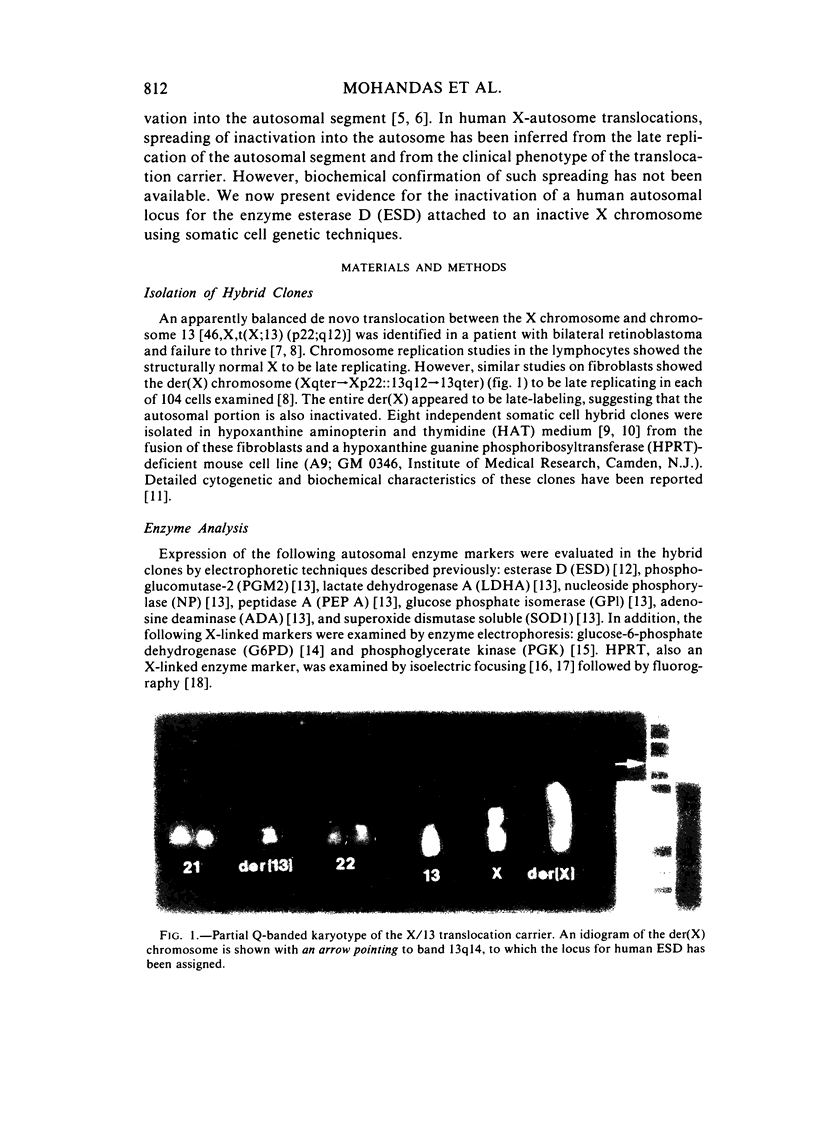
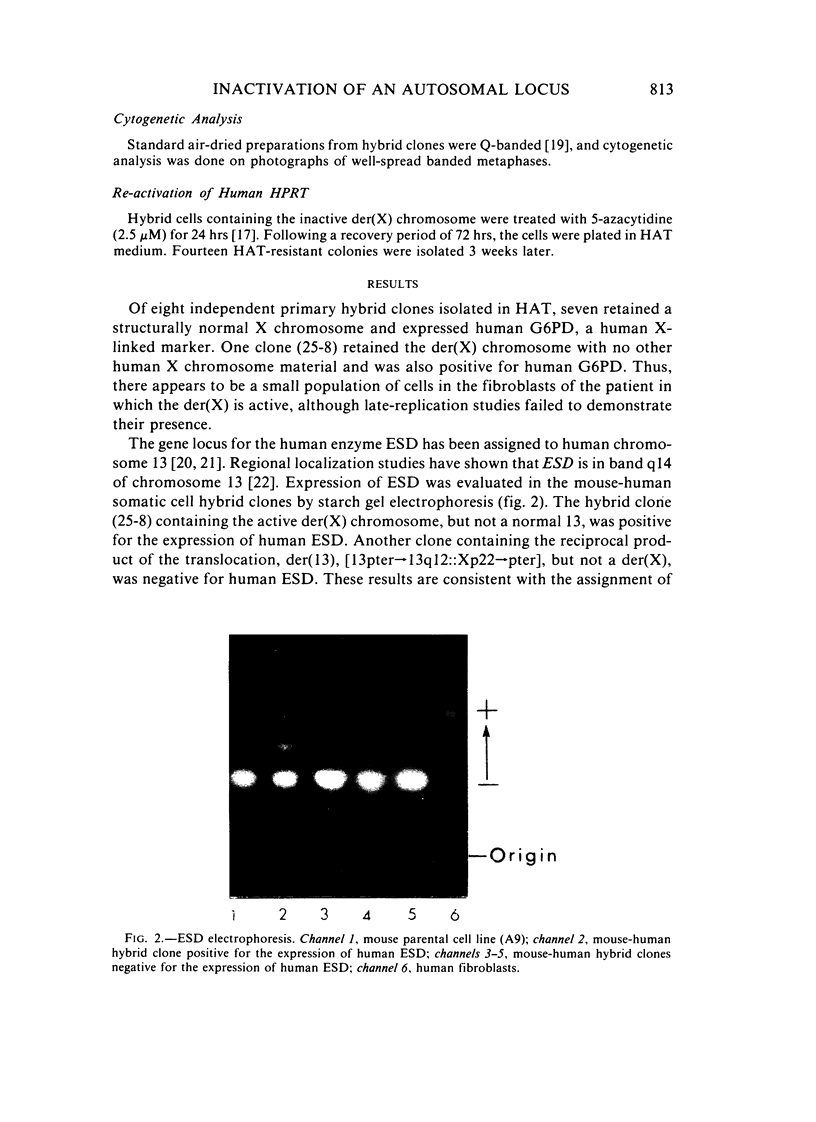
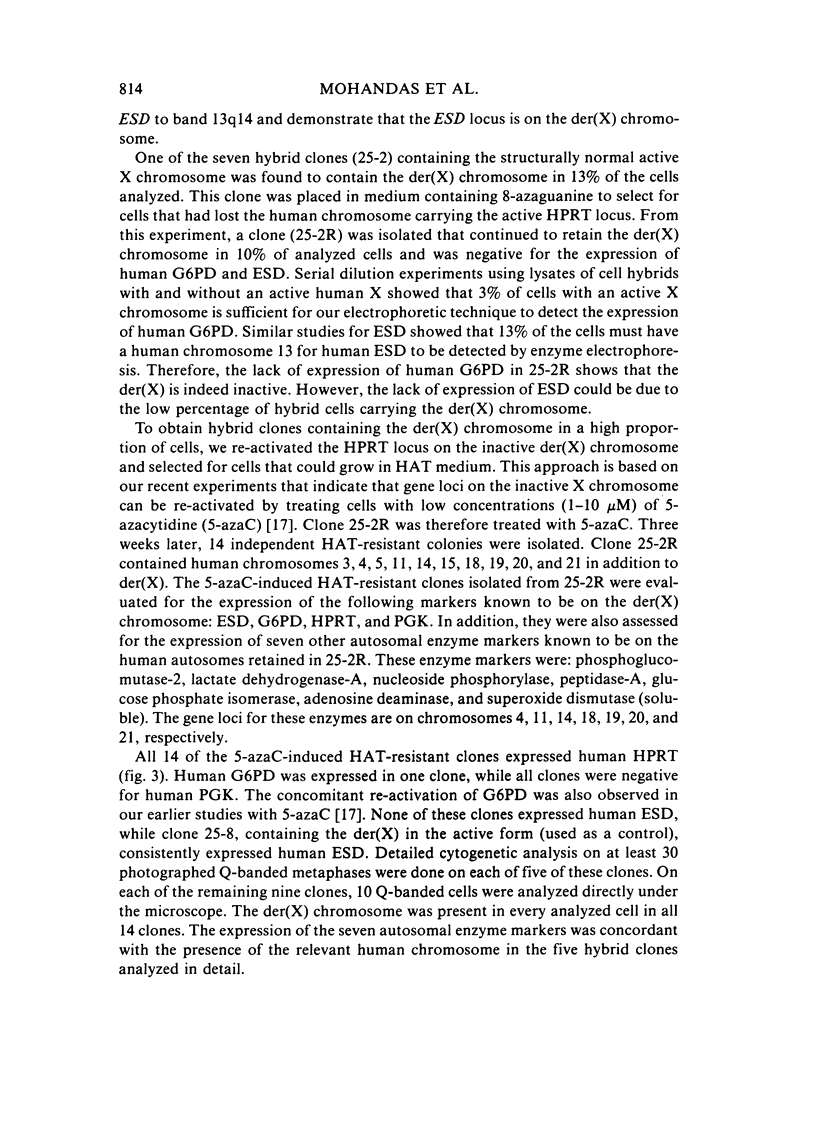
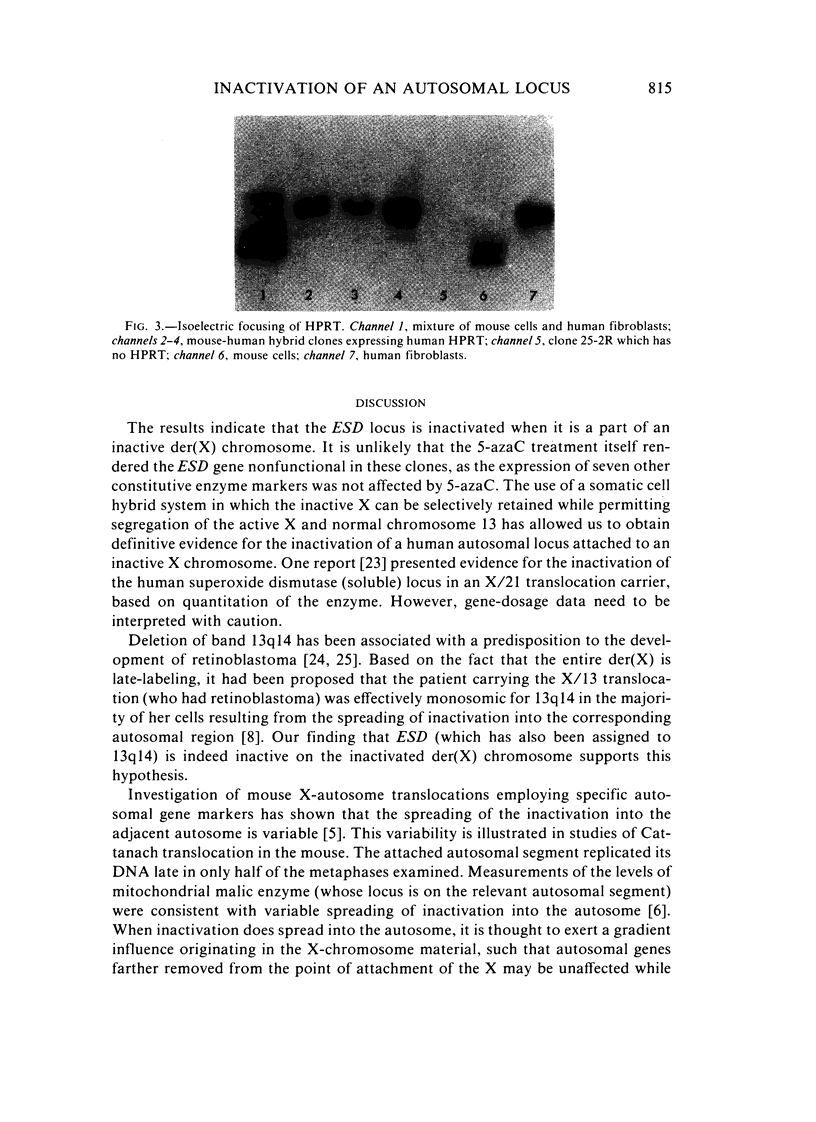
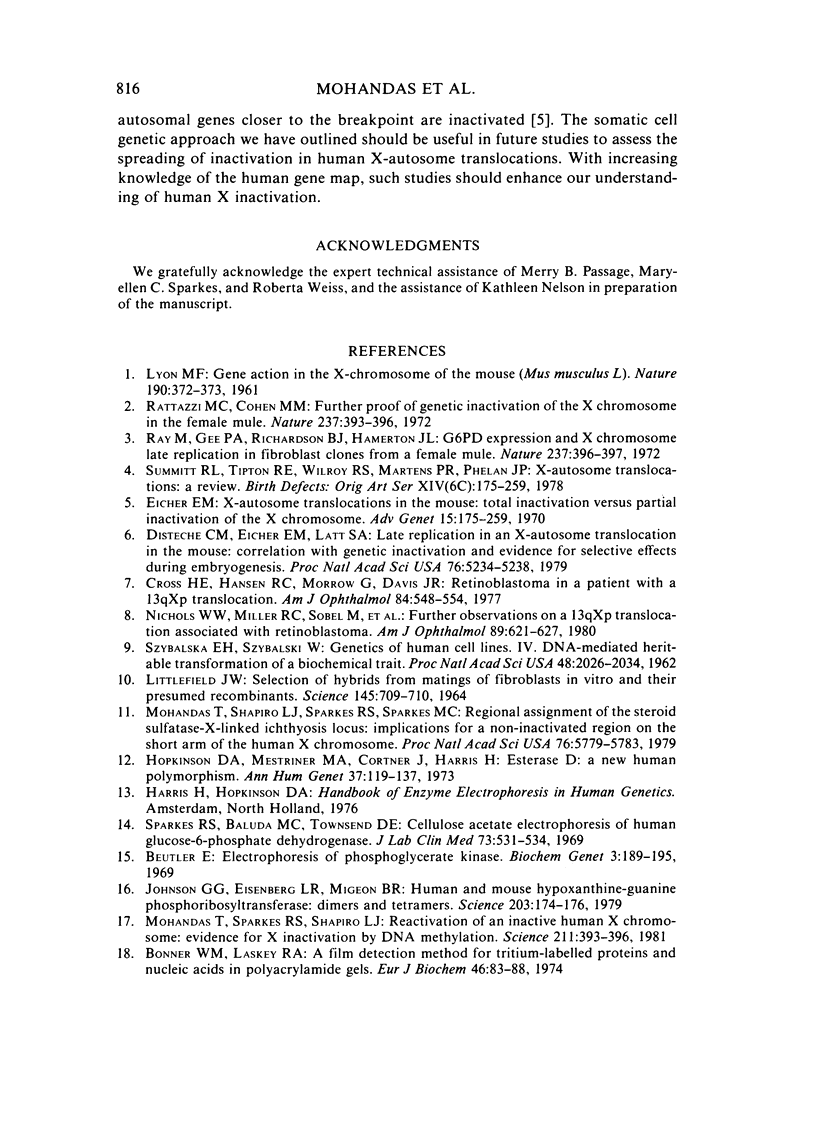
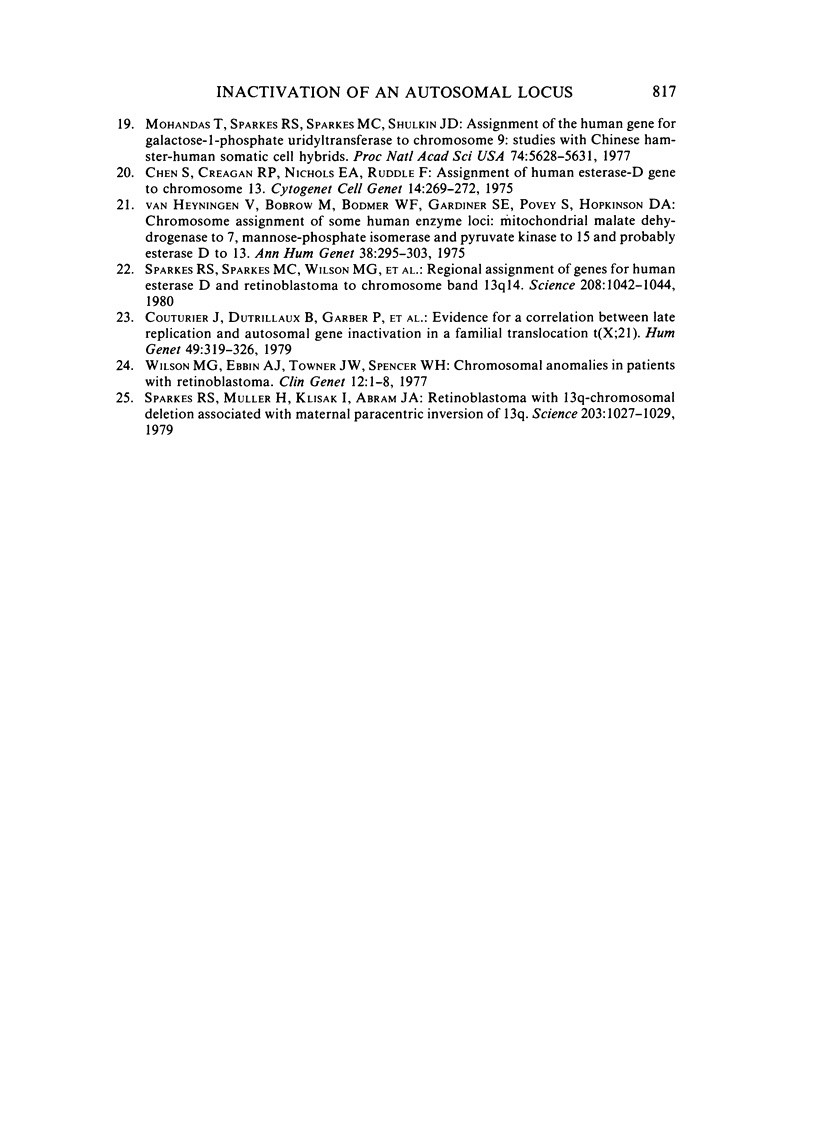
Images in this article
Selected References
These references are in PubMed. This may not be the complete list of references from this article.
- Beutler E. Electrophoresis of phosphoglycerate kinase. Biochem Genet. 1969 Apr;3(2):189–195. doi: 10.1007/BF00520353. [DOI] [PubMed] [Google Scholar]
- Bonner W. M., Laskey R. A. A film detection method for tritium-labelled proteins and nucleic acids in polyacrylamide gels. Eur J Biochem. 1974 Jul 1;46(1):83–88. doi: 10.1111/j.1432-1033.1974.tb03599.x. [DOI] [PubMed] [Google Scholar]
- Chen S., Creagan R. P., Nichols E. A., Ruddle F. H. Assigment of human esterase-D gene to chromosome 13. Cytogenet Cell Genet. 1975;14(3-6):269–272. doi: 10.1159/000130360. [DOI] [PubMed] [Google Scholar]
- Couturier J., Dutrillaux B., Garber P., Raoul O., Croquette M. F., Fourlinnie J. C., Maillard E. Evidence for a correlation between late replication and autosomal gene inactivation in a familial translocation t(X;21). Hum Genet. 1979 Jul 18;49(3):319–326. doi: 10.1007/BF00569351. [DOI] [PubMed] [Google Scholar]
- Cross H. E., Hansen R. C., Morrow G., 3rd, Davis J. R. Retinoblastoma in a patient with a 13qXp translocation. Am J Ophthalmol. 1977 Oct;84(4):548–554. doi: 10.1016/0002-9394(77)90450-0. [DOI] [PubMed] [Google Scholar]
- Disteche C. M., Eicher E. M., Latt S. A. Late replication in an X-autosome translocation in the mouse: correlation with genetic inactivation and evidence for selective effects during embryogenesis. Proc Natl Acad Sci U S A. 1979 Oct;76(10):5234–5238. doi: 10.1073/pnas.76.10.5234. [DOI] [PMC free article] [PubMed] [Google Scholar]
- Eicher E. M. X-autosome translocations in the mouse: total inactivation versus partial inactivation of the X chromosome. Adv Genet. 1970;15:175–259. [PubMed] [Google Scholar]
- Hopkinson D. A., Mestriner M. A., Cortner J., Harris H. Esterase D: a new human polymorphism. Ann Hum Genet. 1973 Oct;37(2):119–137. doi: 10.1111/j.1469-1809.1973.tb01820.x. [DOI] [PubMed] [Google Scholar]
- Johnson G. G., Eisenberg L. R., Migeon B. R. Human and mouse hypoxanthine-guanine phosphoribosyltransferase: dimers and tetramers. Science. 1979 Jan 12;203(4376):174–176. doi: 10.1126/science.569362. [DOI] [PubMed] [Google Scholar]
- LITTLEFIELD J. W. SELECTION OF HYBRIDS FROM MATINGS OF FIBROBLASTS IN VITRO AND THEIR PRESUMED RECOMBINANTS. Science. 1964 Aug 14;145(3633):709–710. doi: 10.1126/science.145.3633.709. [DOI] [PubMed] [Google Scholar]
- LYON M. F. Gene action in the X-chromosome of the mouse (Mus musculus L.). Nature. 1961 Apr 22;190:372–373. doi: 10.1038/190372a0. [DOI] [PubMed] [Google Scholar]
- Mohandas T., Shapiro L. J., Sparkes R. S., Sparkes M. C. Regional assignment of the steroid sulfatase-X-linked ichthyosis locus: implications for a noninactivated region on the short arm of human X chromosome. Proc Natl Acad Sci U S A. 1979 Nov;76(11):5779–5783. doi: 10.1073/pnas.76.11.5779. [DOI] [PMC free article] [PubMed] [Google Scholar]
- Mohandas T., Sparkes R. S., Shapiro L. J. Reactivation of an inactive human X chromosome: evidence for X inactivation by DNA methylation. Science. 1981 Jan 23;211(4480):393–396. doi: 10.1126/science.6164095. [DOI] [PubMed] [Google Scholar]
- Mohandas T., Sparkes R. S., Sparkes M. C., Shulkin J. D. Assignment of the human gene for galactose-1-phosphate uridyltransferase to chromosome 9: studies with Chinese hamster-human somatic cell hybrids. Proc Natl Acad Sci U S A. 1977 Dec;74(12):5628–5631. doi: 10.1073/pnas.74.12.5628. [DOI] [PMC free article] [PubMed] [Google Scholar]
- Nichols W. W., Miller R. C., Sobel M., Hoffman E., Sparkes R. S., Mohandas T., Veomett I., Davis J. R. Further observations on a 13qXp translocation associated with retinoblastoma. Am J Ophthalmol. 1980 May;89(5):621–627. doi: 10.1016/0002-9394(80)90276-7. [DOI] [PubMed] [Google Scholar]
- Rattazzi M. G., Cohen M. M. Further proof of genetic inactivation of the X chromosome in the female mule. Nature. 1972 Jun 16;237(5355):393–396. doi: 10.1038/237393a0. [DOI] [PubMed] [Google Scholar]
- Ray M., Gee P. A., Richardson B. J., Hamerton J. L. G6PD expression and X chromosome late replication in fibroblast clones from a female mule. Nature. 1972 Jun 16;237(5355):396–397. doi: 10.1038/237396a0. [DOI] [PubMed] [Google Scholar]
- SZYBALSKA E. H., SZYBALSKI W. Genetics of human cess line. IV. DNA-mediated heritable transformation of a biochemical trait. Proc Natl Acad Sci U S A. 1962 Dec 15;48:2026–2034. doi: 10.1073/pnas.48.12.2026. [DOI] [PMC free article] [PubMed] [Google Scholar]
- Sparkes R. S., Baluda M. C., Townsend D. E. Cellulose acetate electrophoresis of human glucose-6-phosphate dehydrogenase. J Lab Clin Med. 1969 Mar;73(3):531–534. [PubMed] [Google Scholar]
- Sparkes R. S., Muller H., Klisak I. Retinoblastoma with 13q- chromosomal deletion associated with maternal paracentric inversion of 13q. Science. 1979 Mar 9;203(4384):1027–1029. doi: 10.1126/science.424728. [DOI] [PubMed] [Google Scholar]
- Sparkes R. S., Sparkes M. C., Wilson M. G., Towner J. W., Benedict W., Murphree A. L., Yunis J. J. Regional assignment of genes for human esterase D and retinoblastoma to chromosome band 13q14. Science. 1980 May 30;208(4447):1042–1044. doi: 10.1126/science.7375916. [DOI] [PubMed] [Google Scholar]
- Wilson M. G., Ebbin A. J., Towner J. W., Spencer W. H. Chromosomal anomalies in patients with retinoblastoma. Clin Genet. 1977 Jul;12(1):1–8. doi: 10.1111/j.1399-0004.1977.tb00894.x. [DOI] [PubMed] [Google Scholar]
- van Heyningen V., Bobrow M., Bodmer W. F., Gardiner S. E., Povey S., Hopkinson D. A. Chromosome assignment of some human enzyme loci: mitochondrial malate dehydrogenase to 7, mannosephosphate isomerase and pyruvate kinase to 15 and probably, esterase D to 13. Ann Hum Genet. 1975 Jan;38(3):295–303. doi: 10.1111/j.1469-1809.1975.tb00613.x. [DOI] [PubMed] [Google Scholar]





